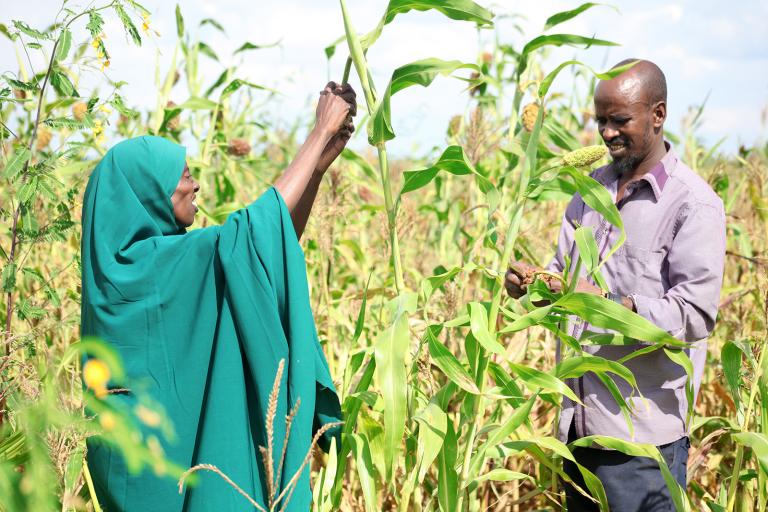WMO and FAO partnering to enhance early warnings for the agriculture sector

Climate Hazards and their Impact on Agriculture
Agricultural communities worldwide face heightened vulnerability to climate hazards including droughts, floods, storm surges, and heatwaves. These extreme weather events can have detrimental effects on agrifood systems and jeopardize all four pillars of food security, namely, availability, access, utilization and stability. Droughts lead to water scarcity, stunting crop growth and cause substantial economic losses for farmers. Floods can destroy entire harvests, erode fertile soil, and disrupt essential agricultural infrastructure. Heatwaves cause heat stress in both plants and livestock, diminishing productivity and increasing mortality rates. This vulnerability is especially pronounced in developing countries, where limited resources and infrastructure exacerbate the challenges posed by climate change. A proactive approach to disaster risk management in agriculture is needed to significantly reduce the risk and vulnerability of agriculture to climate extremes.
Early Warnings for All (EW4All)
Early Warnings for All is a groundbreaking initiative to ensure that everyone on Earth is protected from hazardous weather, water, or climate events through life-saving early warning systems by the end of 2027. As part of the UN Secretary-General’s Acceleration Agenda, the Early Warnings for All initiative is a key contribution to delivering climate justice to those at the frontlines of the climate crisis.
Despite the urgent need, only half of the countries worldwide report having adequate multi-hazard early warning systems, and even fewer have regulatory frameworks that connect early warnings to emergency and response plans. There are also big gaps in the global observing system required to generate forecasts.
The Early Warnings for All (EW4All) initiative brings together the broader UN system, governments, civil society and development partners across the public and private sectors to enhance collaboration and accelerated action to address gaps and deliver people-centered, end-to-end multi-hazard early warning systems that leave no one behind.
Roles of WMO and FAO in EW4All
The Early Warnings for All initiative is spearheaded by the World Meteorological Organization (WMO) and the United Nations Office for Disaster Risk Reduction (UNDRR), with support from the International Telecommunication Union (ITU) and the International Federation of Red Cross and Red Crescent Societies (IFRC). WMO specifically leads Pillar 2 on Observations, Monitoring, Analysis, and Forecasting. The Food and Agriculture Organization of the United Nations (FAO) contributes its expertise in agricultural resilience and food security, helping to generate risk knowledge and tailor early warning systems to the specific needs of farming communities as well as implementing anticipatory actions to mitigate the impact of climate shocks on agriculture and food security. FAO is an active member of the different pillar groups embedding their expertise throughout the MHEWS value cycle with global focus on Pillar 1 (disaster risk knowledge) and Pillar 4 (preparedness to respond) and national actions across all four pillars.
Collaboration between WMO and FAO on EW4All
FAO and WMO are collaborating in various countries on the EW4ALL initiative. A notable example is their partnership in Somalia under the Somalia Water and Land Information Management (SWALIM) project, aimed at enhancing the country's early warning capabilities. This collaboration leverages advanced systems and tools developed by SWALIM, including extensive meteorological and hydrological monitoring networks, sophisticated data management systems, and robust early warning mechanisms. These resources are instrumental in supporting national efforts for disaster preparedness and response, thereby significantly improving Somalia's resilience to climate hazards. Activities under the collaboration in Somalia include integrating meteorological and hydrological stations procured under projects like SWALIM into WMO’s data sharing networks, upgrading Information and Communications Technology (ICT) equipment, conducting data rescue activities and leveraging regional centres for capacity building to enhance forecasts and early warning information.
The actions under the SWALIM project are complemented by the Climate Risk and Early Warning Systems (CREWS) initiative project on Strengthening early warning and early action systems for meteorological, hydrological, and climate extremes in the Greater Horn of Africa.
To further coordinate and collaborate under the implementation of EW4All in the country, WMO, with support from FAO, and working closely with the Somali government, will convene in-country Pillar 2 stakeholders to chart the way for the observation and monitoring components of EW4All. Somalia is also a target country of the Systematic Observations Financing Facility (SOFF) and will be supported to further fill the observation gaps, building on meteorological stations procured by partners such as FAO.
Looking ahead, WMO and FAO anticipate further collaboration to enhance multi-hazard early warning system (MHEWS) capacities and coverage in other countries and contexts, with a focus on those initially being targeted under the EW4All initiative. WMO and FAO will also continue to collaborate more broadly on early warning and anticipatory action including through the El Niño–Southern Oscillation (ENSO) Cell of the Inter-Agency Standing Committee that is led by FAO and for which WMO leads the forecasting component. Through these joint efforts, WMO and FAO aim to enhance the resilience of vulnerable populations, particularly those in climate-sensitive agricultural communities, from the devastating impacts of climate hazards.
- WMO Member:
- Somalia
- Region:
- Region I: Africa

